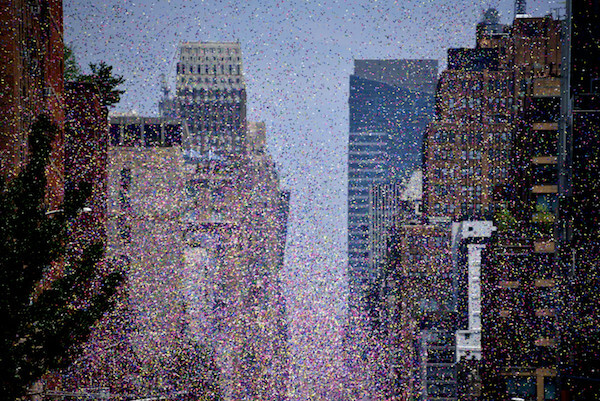A new billboard in Gowanus is hoping to raise awareness about the humanitarian crisis at Rikers Island and remind New Yorkers about their proximity to the infamous jail as part of a new nationwide campaign.
Standing high above Hamilton Place near 13th Street, the billboard features a simple map of parts of Queens, the Bronx, Manhattan — and Rikers, sitting in the East River nearly close enough to touch from the mainland. Rikers is circled in bold red, with red text stating simply “WE ARE HERE.”
The billboard, one of more than 50 erected nationwide as part of a campaign by organization “For Freedoms” titled “Another Justice: By Any Medium Necessary,” was designed by filmmaker and activist Catherine Gund, who said she wanted to use a familiar sight to jolt viewers into thinking about their physical proximity to the facility, which sits just about ten miles away from the billboard.
“You Are Here,” and Rikers is right there
“Specifically, me and Aubin Pictures, our campaign was to use the ‘You Are Here,’ sort of familiar imagery, and to remind people, let people know, whoever the viewer is, whatever their positioning is,” about their physical closeness to Rikers, Gund said. “Some people don’t realize you can walk there from LaGuardia. It’s right there, it’s right here.”
There’s more than just the jail’s location that entwines it with New York City’s population, Gund said. New York City’s jail population as of April was more than 5,000, according to Department of Corrections data, with most of those people housed at Rikers Island, and about 20% of the city’s jail average daily jail population were arraigned in Brooklyn.
“So, if you’re in Brooklyn, there’s people who have been affected by incarceration at Rikers,” she said. “Whether it’s the children of the men and women who are caged there, whether it’s men and women themselves who have been in and out, whether it’s other family members.”

The majority of people in jail at Rikers Island are unsentenced — they have not yet been convicted of a crime, and many are eligible for bail but cannot pay, and a disproportionate number of detainees are people of color, something that has not changed since then-mayor Bill de Blasio first proposed closing Rikers Island in 2017.
The city is slowly moving toward that goal, aiming to completely close the jails on Rikers Island and replace them with smaller jails in four of the five boroughs by 2027. Crews are preparing to demolish the existing jails in Manhattan and Brooklyn, and work is in early stages at the future sites of the Queens and Bronx facilities.
“I thought, what really matters? We need to close Rikers, we’ve been working on this for years,” Gund said. “The old mayor, the old governor both agreed to do it. They were actually tripping all over themselves to do it.”
But conditions at Rikers have not improved, even as the city seeks to avoid a federal takeover of the facility. Six people have died on the island this year, and some detainees say they are not being taken to critical medical appointments. Last fall, local elected officials detailed the overcrowded and unsanitary conditions inside the jail after they toured the island.
“The mistreatment is unbelievable,” said Gund, who has visited jails all over the country over the course of her career. “Rikers is the worst of the worst.”
Art and the end of Rikers Island
The filmmaker said she hopes the billboard to think about the people held at Rikers and the real help they need. According to Beyond Rosie’s, a campaign focused on closing the Rose M. Singer Center, the women’s jail at Rikers, more than 80 percent of women in jail are mothers, and nearly 90 percent have experienced domestic violence over the course of their lives.
“There are possible places for women to go that are about services, they could be building programs and spaces that serve people’s mental health needs, and give them treatment, drug treatment,” Gund said. “And all the basic things about getting people out of dangerous situations, dangerous relationships.”

“It’s not even about rehabilitation, it’s about laying the groundwork of shared safety,” she added.
Taken as a whole, the nationwide campaign shows the depths of the abolitionist movement, Gund said, and the need and desire to end mass incarceration. It’s important to imagine that future if the country is ever going to get to that place.
“It’s an incredibly inspiring, unique, really smart way to pierce … indifference, fatigue,” Gund said. “To see these billboards is so surprising, you’re expecting a commercial, you expect a 1-800 number, you expect to immediately hear a jingle in your head. And instead, there are stories and images and visions that show potential ways to get to safety for all of us.”























